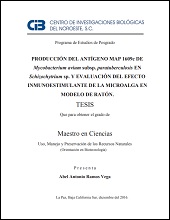Producción del antígeno MAP 1609c de Mycobacterium avium subsp. paratuberculosis en Schizochytrium sp. y evaluación del efecto inmunoestimulante de la microalga en modelo de ratón.
Abstract
Mycobacterium avium subsp. paratuberculosis (MAP) es el agente etiológico de la enfermedad de Johne´s, que es prevalente en todo el mundo y por lo tanto es necesario el desarrollo de vacunas más eficaces, de bajo costo de producción y con altos rendimientos. Las microalgas son utilizadas como plataforma de producción de antígenos vacunales. Particularmente, Schizochytrium sp. produce compuestos benéficos para la salud humana y animal; algunos de esas biomoléculas tienen propiedades inmunogénicas naturales que la hacen interesante para la producción y entrega de vacunas recombinantes. El objetivo de esta investigación fue determinar la producción de un antígeno de MAP en Schizochytrium sp. y evaluar la actividad inmunoestimulante de la microalga al ser co-administrada vía oral con el Ag85b recombinante purificado en modelo de ratón. Para ello se realizó la transformación genética de la microalga mediante Agrobacterium tumefaciens con la construcción pH7m24GW,3-35SCaMV::MAP85B y se evaluó la expresión transitoria del antígeno mediante inmunoblots. Posteriormente, se evaluó la inmunogenicidad de la microalga en modelo de ratón BALB/c a través de su co-administración vía oral con el Ag85b recombinante purificado. Se establecieron grupos de ratones (n = 5) que recibieron los siguientes tratamientos: Grupo 1, Control (100 μL PBS); grupo 2, 10 μg de antígeno 85b purificado/100 μL PBS; grupo 3, 100 mg de Schizochytrium sp. ATCC 20888/100 μL PBS; grupo 4, 100 mg Schizochytrium sp. ATCC 20888 más 10 μg de antígeno 85b purificado/100μL PBS; grupo 5, 100 mg Schizochytrium sp. comercial más 10 μg de antígeno 85b purificado. Los resultados de la expresión transitoria mostraron una producción del rAg85b por parte de la microalga a las 48 y 72 horas después del cocultivo. La coadministración de Schizochytrium sp. con el Ag85b aumenta la producción de IgA total en mucosas, además, reduce el número de células apoptóticas en etapa temprana y una mayor producción de radicales libres por parte de leucocitos de bazo de ratón. De manera relevante, todos los tratamientos tuvieron una reducción de células apoptóticas en etapa tardía en comparación con el control [...] Mycobacterium avium subsp. paratuberculosis (MAP) is the etiological agent of Johne's disease, which is common all over the world and therefore is necessary the development of more effective vaccines, low cost of production and with high yields. Microalgae are used as a platform for the production of antigens vaccine. In particular, Schizochytrium sp. produces beneficial compounds for human and animal health; some of these biomolecules have natural immunogenic properties that make them interesting for the production and delivery of recombinant vaccines. The objective of this investigation was to determine the production of a MAP antigen in Schizochytrium sp.; additionally, to evaluate the immunostimulatory activity of the microalgae when co-administered orally with recombinant Ag85b purified in mouse model. For this, the genetic transformation of the microalga was carried out using Agrobacterium tumefaciens with the construction pH7m24GW,3-35SCaMV::MAP85B and the transient expression of the antigen was evaluated by immunoblots. Subsequently, the immunogenicity of Schizochytrium sp. in the BALB/c mouse model was evaluated via oral co-administration with the purified recombinant Ag85b. Groups of mice (n = 5) were established that received the following treatments: group 1, control (100 μL PBS); group 2, 10 μg of purified Ag85b/100 μl PBS; group 3, 100 mg of Schizochytrium sp. ATCC 20888/100 μl PBS; group 4, 100 mg Schizochytrium sp. ATCC 20888 plus 10 μg of purified Ag85b/100 μl PBS; group 5, 100 mg Schizochytrium sp. commercial plus 10 μg of purified Ag85b. The results of transient expression showed a production of Ag85b by the microalga at 48 and 72 hours after co-culture. The co-administration of Schizochytrium sp. with Ag85b increases the total IgA production in the mucosa; in addition, it reduces the number of early apoptotic cells and a greater production of free radicals by leukocytes isolates of mouse spleen. Significantly, all treatments had a reduction in a late apoptotic cell stage compared to the control [...]
Collections
Related items
Showing items related by title, author, creator and subject.
-
PROMOCIÓN DEL PERIFITON PARA EL CULTIVO DE CAMARÓN BLANCO: HACIA UNA ACUICULTURA ECOLÓGICA
DOMENICO VOLTOLINA LOBINA; JUAN MANUEL AUDELO NARANJO; MARIA DEL ROSARIO PACHECO MARGES -
Suelo y Erosión
YOLANDA LOURDES MAYA DELGADO


